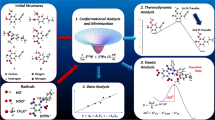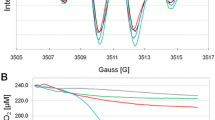Abstract
Reactive oxygen species (ROS) can oxidize and thus damage DNA. Exposure to high levels of ROS is therefore linked with the development of severe illnesses such as cancer, diabetes, and coronary heart disease. Effective treatments for these diseases are yet to be found, despite intensive research. However, it is known that the natural nonenzymatic repair of DNA damage using phytophenols occurs more rapidly than the corresponding enzymatic repair process. Carvacrol, thymol, thymohydroquinone, and p-cymene-2,3-diol are strong natural antioxidant phytophenols that are found in medicinal plants. Their antioxidant activities, which involve reacting with and eliminating ROS before they reach and damage DNA, were studied in this work. Homolytic and heterolytic antioxidant mechanisms that allow these phytophenol antioxidants to eliminate the ROS .OH and .O2− in both vacuum and water (physiological environment) were investigated using density functional theory (DFT). The results showed that the homolytic mechanism is preferred in vacuum, whereas the heterolytic mechanisms are more probable in polar environments. In addition, the electronic properties of these phytophenols were studied and correlated with their antioxidant activities. It appears that these phytophenols can be used as antioxidants in vitro and in vivo to protect living systems from dangerous ROS.

Antioxidant reaction of carvacrol with OH. and .O-2 radicals








Similar content being viewed by others
References
Scialò F et al (2016) Mitochondrial ROS produced via reverse electron transport extend animal lifespan. Cell Metab 23:725–734
Treml J, Smejkal K (2016) Flavonoids as potent scavengers of hydroxyl radicals. Compr Rev Food Sci Food Saf 15:720–738
Lu AL, Li X, Gu Y, Wright PM, Chang DY (2001) Repair of oxidative DNA damage: mechanisms and functions. Cell Biochem Biophys 35:141–170
Giroux X et al (2017) Maladaptive DNA repair is the ultimate contributor to the death of trimethoprim-treated cells under aerobic and anaerobic conditions. Proc Natl Acad Sci 14:11512–11517
Khan F et al (2017) Protective effect of Nigella sativa oil on cisplatin induced nephrotoxicity and oxidative damage in rat kidney. Biomed Pharmacother 85:7–15
Majdalawieh AF, Fayyad MW (2016) Recent advances on the anti-cancer properties of Nigella sativa, a widely used food additive. J Ayurveda Integr Med 7:173–180
Shahroudi MJ, Mehri S, Hosseinzadeh H (2017) Anti-aging effect of Nigella sativa fixed oil on D-galactose-induced aging in mice. Aust J Pharm 20:29–35
Ashakan JJ, Morjan JJ (2014) Electronic structure of some thymol derivatives structure of some thymol derivatives correlated with the radical scavenging activity: theoretical study. Food Chem 165:451–459
Benkaci-A F, Baaliouamer A, Meklati BY, Chemat F (2007) Chemical composition of seed essential oils from Algerian Nigella sativa extracted by microwave and hydrodistillation. Flavour Fragr J 22:148–153
Mancini E, Senatore F, Monte DD, Martino LD, Grulova D, Scognamiglio M, Snoussi M, Feo VD (2015) Studies on chemical composition, antimicrobial and antioxidant activities of five Thymus vulgaris L. essential oils. Molecules 20:12016–12028
Lee SJ, Umano K, Shibamoto T, Lee KG (2005) Identification of volatile components in basil (Ocimum basilicum L.) and thyme leaves (Thymus vulgaris L.) and their antioxidant properties. Food Chem 91:131–137
Ekowati H, Prasasti E, Rastuti U (2011) The active fraction from Nigella sativa and its activity against T47D cell line. Indones J Chem 11:217–222
Du E, Gan L, Li Z, Wang W, Liu D, Guo Y (2015) In vitro antibacterial activity of thymol and carvacrol and their effects on broiler chickens challenged with Clostridium perfringens. J Anim Sci Biotechnol 6:1–10
Beena, Kumar D, Rawat DS (2013) Synthesis and antioxidant activity of thymol and carvacrol based Schiff bases. Bioorg Med Chem Lett 23:641–645
Aeschbach R, Löliger J, Scott BC, Murcia A, Butler J, Halliwell B (1994) Antioxidant actions of thymol, carvacrol, 6-gingerol, zingerone and hydroxytyrosol. Food Chem Toxicol 32:31–36
Fair RJ, Tor Y (2014) Antibiotics and bacterial resistance in the 21st century. Perspect Med Chem 6:25–64
Nostro A et al (2007) Effects of oregano, carvacrol and thymol on Staphylococcus aureus and Staphylococcus epidermidis biofilms. J Med Microbiol 56:519–523
Marsik P, Kokoska L, Landa P, Nepovim A, Soudek P, Vanek T (2005) In vitro inhibitory effects of thymol and quinones of Nigella sativa seeds on oxygenase-1- and -2-catalyzed prostaglandin E2. Planta Med 71:739–742
Sharma P, Jha AB, Dubey RS, Pessarakli M (2012) Reactive oxygen species, oxidative damage and antioxidative defense mechanism in plants under stressful conditions. J Bot 2012:1–26
Koppenol WH (2001) The Haber–Weiss cycle: 70 years later. Redox Rep 6:229–234
Lietal JK (2016) Natural plant polyphenols for alleviating oxidative damage in man: current status and future perspectives. Trop J Pharm Res 15(5):1089–1098
Nisha K et al (2011) Antioxidants and their protective action against DNA damage. Int J Pharm Pharm Sci 3:28–32
Aparicio S (2010) A systematic computational study on flavonoids. Int J Mol Sci 11:2017–2038
Frisch MJ et al. (2009) Gaussian 09, revision A.02. Gaussian, Inc., Wallingford
Najafi M, Zahedi M, Klein E (2011) DFT/B3LYP study of the solvent effect on the reaction enthalpies of homolytic and heterolytic O–H bond cleavage in mono-substituted chromans. Comput Theor Chem 978:16–28
Adam V, Ján R, Vladimír L, Erik K (2011) DFT/B3LYP study of the enthalpies of homolytic and heterolytic O–H bond dissociation in sterically hindered phenols. Acta Chim Slov 4:55–71
Wang Y, Xue L, An Y, Liu (2015) Theoretical study on the structural and antioxidant properties of some recently synthesised 2,4,5-trimethoxy chalcones. Food Chem 171:89–97
Chen Y, Xiao H, Zheng J, Liang G (2015) Structure–thermodynamics–antioxidant activity relationships of selected natural phenolic acids and derivatives: an experimental and theoretical evaluation. PLoS One 10:1–20
Urbaniak A, Molski M, Szeląg M (2012) Quantum-chemical calculations of the antioxidant properties of trans-p-coumaric acid and trans-sinapinic acid. CMST 18:1–12
Najafi M, Nazarparvar E, Mood KH, Zahedi M, Klein E (2011) DFT/B3LYP study of the substituent effects on O–H bond dissociation enthalpies of chroman derivatives in the gas phase and solvent environment. Comput Theor Chem 965:114–122
Klein E, Rimarčík J, Luke V (2009) DFT/B3LYP study of the O–H bond dissociation enthalpies and proton affinities of para- and meta-substituted phenols in water and benzene. Acta Chim Slov 2:37–51
Najafi M, Farmanzadeh D, Klein E, Zahedi M (2013) A theoretical study on the enthalpies of homolytic and heterolytic N–H bond cleavage in substituted melatonins in the gas phase and aqueous solution. Acta Chim Slov 60:43–55
Gutiérrez R, Layeb M, Domingo H (2015) A DFT comparative study of the mechanisms of Lewis acid and Brønsted acid catalysed Povarov reactions. Tetrahedron 71:9339–9345
Alokam R, Jeankumar VU, Sridevi JP, Matikonda SS, Peddi S, Alvala M (2014) Identification and structure–activity relationship study of carvacrol derivatives as Mycobacterium tuberculosis chorismate mutase inhibitors. J Enzyme Inhib Med Chem 29:547–554
Cherrak SA, Soulimane NM, Berroukeche F, Bensenane B, Cherbonnel A, Merzouk H, Elhabiri M (2016) In vitro antioxidant versus metal ion chelating properties of flavonoids: a structure–activity investigation. PLoS One 11:e0165575
Bakhouche K, Dhaouadi Z, Jaidane N, Hammoutène D (2015) Comparative antioxidant potency and solvent polarity effects on HAT mechanisms of tocopherols. Comp Theor Chem 1060:58–65
Chen F, Nielsen S, Zenobi R (2013) Understanding chemical reactivity for homo- and heterobifunctional protein crossinking agents. J Mass Spectrom 48:807–812
Kaya S, Kaya C (2014) Investigation of relationship with electron configuration of chemical hardness, absolute electronegativity and electrophilicity. J Phys Theor Chem 11:1–13
Klein E, Rimarčík J, Senajová E, Vagánek A, Lengyel J (2016) Deprotonation of flavonoids severely alters the thermodynamics of the hydrogen atom transfer. Comp Theor Chem 1085:7–17
El Hassane A, Syed AA, Normahanim BH, Najoua EM, Rohaya A, Weber F, Frédéric J, Mohd Z (2014) Antioxidant activity of hispidin oligomers from medicinal fungi: a DFT study. Molecules 19:3489–3507
Guitard R, Nardello-Rataj V, Aubry J-M (2016) Theoretical and kinetic tools for selecting effective antioxidants: application to the protection of omega-3 oils with natural and synthetic phenols. Int J Mol Sci 17:1–25
Nsangou M, Dhaouadi Z, Jaidane N, Lakhdar ZB (2008) DFT study of the structure of hydroxybenzoic acids and their reactions with .OH and .O− 2 radicals. J Mol Struct 850:135–143
Dhaouadi Z, Nsangou M, Garrab N, Anouar EH, Marakchi K, Lahmar S (2009) DFT study of the reaction of quercetin with .O− 2 and .OH radicals. J Mol Struct 940:35–42
Habtemariam S (2018) Antidiabetic potential of monoterpenes: a case of small molecules punching above their weight. Int J Mol Sci 19:1–23
Author information
Authors and Affiliations
Corresponding author
Rights and permissions
About this article
Cite this article
Zerrouki, M., Benkaci-Ali, F. DFT study of the mechanisms of nonenzymatic DNA repair by phytophenolic antioxidants. J Mol Model 24, 78 (2018). https://doi.org/10.1007/s00894-018-3599-6
Received:
Accepted:
Published:
DOI: https://doi.org/10.1007/s00894-018-3599-6




